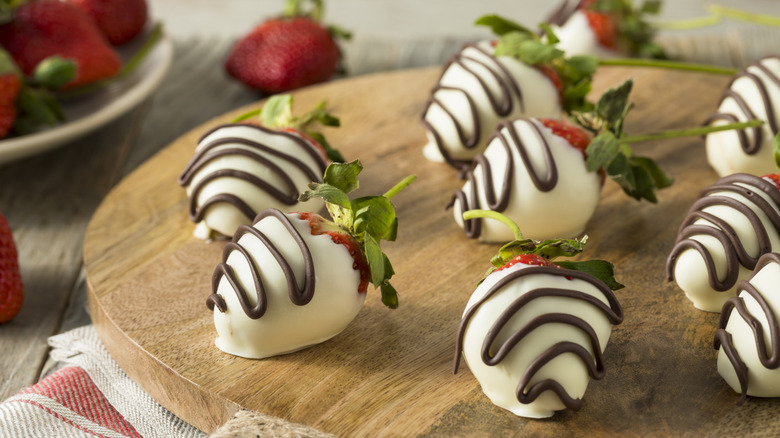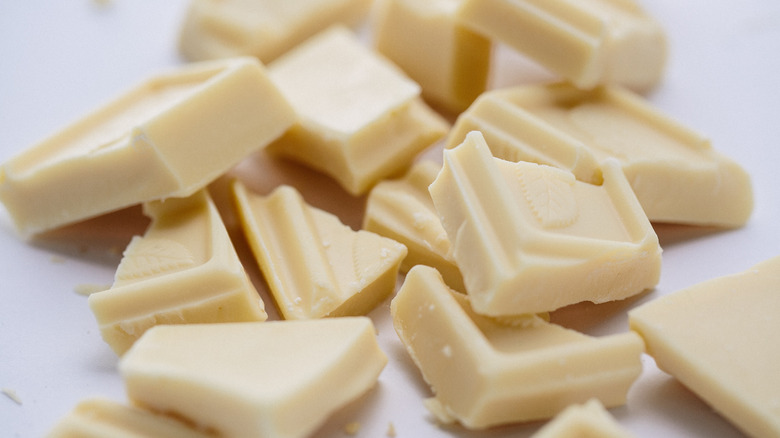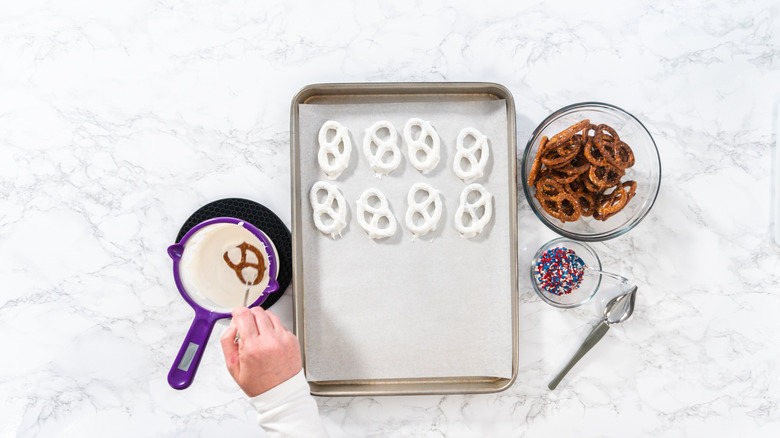White Chocolate Vs Candy Melts: What's The Difference?
White chocolate, the divisive, super sweet cousin of classic chocolate, and candy melts, the disks of chocolate-like sugar and oil found in the baking aisle, have similar strengths that recommend them. While neither would be chosen for their decadent quality or rich depth of flavor, they both have an essential role to play in decorative snacks and show-stopping confections.
Tempered white chocolate and hardened candy melts both melt consistently and quickly into a smooth, glossy mixture that's perfect for dipping and drizzling. They cool into a firm texture with a satisfying snap, which is excellent for coating, molding, and decorating various treats. And they both have a smooth, sweet finish that complements chocolate, fruit, pretzels, cookies, gingerbread, cereal snack mixes, Rice Krispie Treats, marshmallows, and decorative cakes and cupcakes.
But apart from their usual uses, white chocolate and candy melts don't have much in common. They're comprised of different ingredients, they harden into textures with different mouthfeels, they vary in price, and they melt at different temperatures. Here's what to know about their key differences and how to decide which chocolate-like option will work best for your culinary needs.
What is white chocolate, exactly?
White chocolate has long been a victim of the notion that it doesn't actually have any "chocolate" in it. This idea partially stems from the FDA previously ruling against white chocolate as "real" chocolate. But all chocolate, whether lightly colored milk chocolate, richly bitter dark chocolate, or yes, even white chocolate, comes from cocoa beans. Cacao nibs from the beans are ground into cocoa liquor which, when pressed, separates into cacao solids and cacao fat, or cocoa butter. Milk chocolate and dark chocolate are made with both the solids and the fat. White chocolate is made with just cocoa butter. That's why it's light in color and very light on chocolatey flavor.
Nowadays, to be considered chocolate in the U.S., white chocolate must include 20% cocoa butter, which gives it a buttery, creamy mouthfeel. But most of white chocolate is made up of sugar and milk solids. That's why it tastes super sweet, but still has the same milky taste we associate with chocolate. Despite its low cocoa percentage, white chocolate is still chocolate (and its price reflects that fact). That means it must be tempered when melted, whether in the microwave or on the stovetop, to achieve that satisfying snap and glossy finish. You can find white chocolate in the baking aisle of your local grocery store and swap it in for recipes that require any chocolate in any form for a sweeter finish.
What are candy melts, exactly?
Unlike white chocolate, wafer-shaped candy melts aren't made with cocoa butter, just sugar, oil, and milk solids. Certain varieties might have an added flavor or color, but overall a candy melt will taste fairly one dimensionally of sugar. The oil in candy melts allows them to melt quickly and consistently, no temperamental tempering needed, though you might want to thin out your candy melts with more oil. Candy melts are also forgiving of added food coloring, so you can create vivid colors for all your confectionary needs.
After dipping your pretzel, graham cracker, or strawberry into a dish of melted candy melts, you'll notice the coating hardens quickly, so you'll want to work fast to add any other toppings like sprinkles or cookie crumbles. Although the quick-drying coating makes candy melts easy to use, it will give your desserts a slightly waxy taste. When deciding whether to use white chocolate versus candy melts, your choice will likely come down to taste versus aesthetics. Though slightly harder to find, candy melts are available in many grocery stores and in specialty baking stores. Plus, they're usually quite cheap when compared with chocolate. So, get your double boilers bubbling and your wafers and bars melting to see which ingredient suits your baking best.


